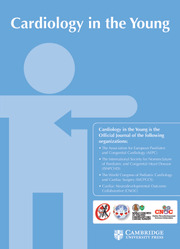Crossref Citations
This article has been cited by the following publications. This list is generated based on data provided by
Crossref.
Glotzbach, Kristi
May, Lindsay
and
Wray, Jo
2018.
Health related quality of life and functional outcomes in pediatric cardiomyopathy.
Progress in Pediatric Cardiology,
Vol. 48,
Issue. ,
p.
26.
McBride, Michael G.
Burstein, Danielle S.
Edelson, Jonathan B.
and
Paridon, Stephen M.
2020.
Cardiopulmonary Rehabilitation in Pediatric Patients With Congenital and Acquired Heart Disease.
Journal of Cardiopulmonary Rehabilitation and Prevention,
Vol. 40,
Issue. 6,
p.
370.
Wray, Jo
Marino, Bradley S.
and
Uzark, Karen
2020.
Pediatric and Congenital Cardiology, Cardiac Surgery and Intensive Care.
p.
1.
Cirino, Allison L.
Harris, Stephanie L.
Murad, Andrea M.
Hansen, Brittany
Malinowski, Jennifer
Natoli, Jaime L.
Kelly, Melissa A.
and
Christian, Susan
2022.
The uptake and utility of genetic testing and genetic counseling for hypertrophic cardiomyopathy—A systematic review and meta‐analysis.
Journal of Genetic Counseling,
Vol. 31,
Issue. 6,
p.
1290.
Edelson, Jonathan B.
Stanley, Helen M.
Min, Jungwon
Burstein, Danielle S.
Lane-Fall, Meghan
O’Malley, Shannon
Shah, Maully
McBride, Michael G.
Stephens, Paul
Griffis, Heather
Weber, Carol Wittlieb
O’Connor, Matthew J.
Rossano, Joseph W.
Lin, Kimberly Y.
and
Paridon, Stephen M.
2022.
Cardiopulmonary Exercise Testing in Pediatric Patients With Hypertrophic Cardiomyopathy.
JACC: Advances,
Vol. 1,
Issue. 4,
p.
100107.
Masood, Imran R.
and
Edelson, Jonathan B.
2023.
Exercise and Sports Participation in Children with Cardiomyopathy: A Review.
Current Treatment Options in Cardiovascular Medicine,
Vol. 25,
Issue. 10,
p.
543.
Lawley, Claire M.
and
Kaski, Juan Pablo
2023.
Clinical and Genetic Screening for Hypertrophic Cardiomyopathy in Paediatric Relatives: Changing Paradigms in Clinical Practice.
Journal of Clinical Medicine,
Vol. 12,
Issue. 8,
p.
2788.
Kaski, Juan Pablo
Kammeraad, Janneke A.E.
Blom, Nico A.
Happonen, Juha-Matti
Janousek, Jan
Klaassen, Sabine
Limongelli, Giuseppe
Östman-Smith, Ingegerd
Sarquella Brugada, Georgia
and
Ziolkowska, Lidia
2023.
Indications and management of implantable cardioverter-defibrillator therapy in childhood hypertrophic cardiomyopathy.
Cardiology in the Young,
Vol. 33,
Issue. 5,
p.
681.
Arbelo, Elena
Protonotarios, Alexandros
Gimeno, Juan R
Arbustini, Eloisa
Barriales-Villa, Roberto
Basso, Cristina
Bezzina, Connie R
Biagini, Elena
Blom, Nico A
de Boer, Rudolf A
De Winter, Tim
Elliott, Perry M
Flather, Marcus
Garcia-Pavia, Pablo
Haugaa, Kristina H
Ingles, Jodie
Jurcut, Ruxandra Oana
Klaassen, Sabine
Limongelli, Giuseppe
Loeys, Bart
Mogensen, Jens
Olivotto, Iacopo
Pantazis, Antonis
Sharma, Sanjay
Van Tintelen, J Peter
Ware, James S
Kaski, Juan Pablo
Charron, Philippe
Imazio, Massimo
Abdelhamid, Magdy
Aboyans, Victor
Arad, Michael
Asselbergs, Folkert W
Asteggiano, Riccardo
Bilinska, Zofia
Bonnet, Damien
Bundgaard, Henning
Cardim, Nuno Miguel
Čelutkienė, Jelena
Cikes, Maja
De Ferrari, Gaetano Maria
Dusi, Veronica
Falk, Volkmar
Fauchier, Laurent
Gandjbakhch, Estelle
Heliö, Tiina
Koskinas, Konstantinos
Kotecha, Dipak
Landmesser, Ulf
Lazaros, George
Lewis, Basil S
Linhart, Ales
Løchen, Maja-Lisa
Meder, Benjamin
Mindham, Richard
Moon, James
Nielsen, Jens Cosedis
Petersen, Steffen
Prescott, Eva
Sheppard, Mary N
Sinagra, Gianfranco
Sitges, Marta
Tfelt-Hansen, Jacob
Touyz, Rhian
Veltrop, Rogier
Veselka, Josef
Wahbi, Karim
Wilde, Arthur
Zeppenfeld, Katja
Kichou, Brahim
Sisakian, Hamayak
Scherr, Daniel
Gerber, Bernhard
Džubur, Alen
Gospodinova, Mariana
Planinc, Ivo
Moustra, Hera Heracleous
Zemánek, David
Jensen, Morten Steen Kvistholm
Samir, Ahmad
Palm, Kairit
Heliö, Tiina
Wahbi, Karim
Schulze-Bahr, Eric
Haralambos, Vlachopoulos
Sepp, Róbert
Aðalsteinsdóttir, Berglind
Ward, Deirdre
Blich, Miry
Sinagra, Gianfranco
Poniku, Afrim
Lunegova, Olga
Rudzitis, Ainars
Kassab, Roland
Barysienė, Jūratė
Huijnen, Steve
Felice, Tiziana
Vataman, Eleonora
Pavlovic, Nikola
Doghmi, Nawal
Asselbergs, Folkert W
Kostovska, Elizabeta Srbinovska
Almaas, Vibeke Marie
Biernacka, Elżbieta Katarzyna
Brito, Dulce
Rosca, Monica
Zavatta, Marco
Ristic, Arsen
Goncalvesová, Eva
Šinkovec, Matjaž
Cañadas-Godoy, Victoria
Platonov, Pyotr G
Saguner, Ardan M
Saadi, Ahmad Rasheed Al
Kammoun, Ikram
Celik, Ahmet
Nesukay, Elena
Abdullaev, Timur
Prescott, Eva
James, Stefan
Arbelo, Elena
Baigent, Colin
Borger, Michael A
Buccheri, Sergio
Ibanez, Borja
Køber, Lars
Koskinas, Konstantinos C
McEvoy, John William
Mihaylova, Borislava
Mindham, Richard
Neubeck, Lis
Nielsen, Jens Cosedis
Pasquet, Agnes
Rakisheva, Amina
Rocca, Bianca
Rossello, Xavier
Vaartjes, Ilonca
Vrints, Christiaan
Witkowski, Adam
and
Zeppenfeld, Katja
2023.
2023 ESC Guidelines for the management of cardiomyopathies.
European Heart Journal,
Vol. 44,
Issue. 37,
p.
3503.
Brosig, Susann
Wagner, Robert
Twal, Rabie
Meier, Sabine
Vollroth, Marcel
Markel, Franziska
Dähnert, Ingo
Kostelka, Martin
and
Paech, Christian
2024.
“Quality of life” analysis in the long-term follow-up after “Fontan” palliation for CHDs—a single-centre experience.
Cardiology in the Young,
p.
1.
Potterton, Amanda
Shaughnessy, Lynda
Wootton, Marcus
Sharma, Sanjay
and
Wray, Jo
2024.
The psychological impact of the diagnostic pathway for inherited cardiac conditions in children and adolescents: A systematic review of the literature.
Progress in Pediatric Cardiology,
Vol. 72,
Issue. ,
p.
101702.
Shafqat, Areez
Shaik, Abdullah
Koritala, Snygdha
Mushtaq, Ali
Sabbah, Belal Nedal
Nahid Elshaer, Ahmed
and
Baqal, Omar
2024.
Contemporary review on pediatric hypertrophic cardiomyopathy: insights into detection and management.
Frontiers in Cardiovascular Medicine,
Vol. 10,
Issue. ,





